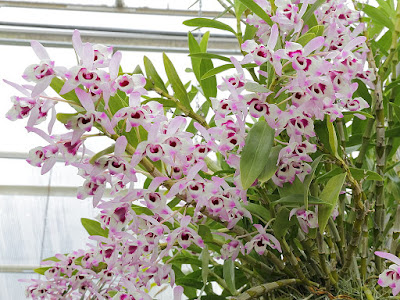Dendrobium nobile is native to Southeast Asia: Nepal, Sikkim, Bhutan, north-east India, Burma, Thailand, Laos, Vietnam and much of southern China...
Dendrobium nobile also called as The Noble Dendrobium, Callista nobilis, Dendrobium coerulescens, Dendrobium formosanum, Dendrobium lindleyanum, Dendrobium nobile f. nobilius, Dendrobium nobile var. alboluteum, Dendrobium nobile var. formosanum, Dendrobium nobile var. nobilius, Dendrobium nobile virginale, Dendrobium wallichianum, is a species of the genus Dendrobium. This species was described by John Lindley in 1830.
IDENTIFY DENDROBIUM NOBILE
Dendrobium nobile is native to Southeast Asia: Nepal, Sikkim, Bhutan, north-east India, Burma, Thailand, Laos, Vietnam and much of southern China. In India, plants grow at heights from 200 to 2,000 m above sea level. They are also widespread in the north of Thailand at altitudes from 600 to 1500 m.
It is a medium sized, cool to hot growing terrestrial or lithophytic species, which reaching 60-90 cm in height, with erect, clustered, compressed, grooved with age, yellowish, 60-90 cm long stems carrying distichous, coriaceous, strap shaped or oblong, persistent, 7-10 cm long leaves.
The Noble Dendrobium blooms mostly in the winter and spring but is possible throughout the year on short, 2 to 4 flowered racemes with fragrant, waxy, heavy-textured, long-lived, highly variable flowers that arise at the upper nodes of leafed and leafless canes. The flowers are 6-10 cm in diameter and are waxy with a distinct texture. Oval petals of the outer whorl and wider wavy edges of the inner whorl are usually white with a pink tip. The mossy cap, cylindrical at the base, is creamy-white with a pink tip and has deep crimson or crimson purple spots in the throat. Sometimes it is pure white. The flowers are very changeable - occasionally even pure white.
DENDROBIUM NOBILE CARE AND CULTURE
Light:
Dendrobium nobile needs a light level of 30000-40000 lux in summer. That plants should be slightly shaded from spring to autumn, but the level of light should be as high as possible, so as not to let the leaves burn.
Temperature:
The average temperature of the summer day is 26-28 ° C, the night 19-20 ° C, giving a daily difference of 7-9 ° C. In spring, the average day temperature is 30-31 ° C, the night 12-19 ° C, and the daily difference is 11-18 ° C. The average temperature of the winter day is 25-28 ° C, the night 9-10 ° C, and the daily difference is 15-18 ° C.
Humidity:
In summer, The Noble Dendrobium needs the average humidity of almost 80%, then dropping to nearly 60% in winter.
Substrate, growing media and repotting:
It is recommended to mount Dendrobium nobile on tree fern rootstock because of their hanging habit. You can place a sphagnum pillow between the washer and the plant. When mounting on rootstocks, you need ensure high humidity and watered at least once a day in summer.
If you have to grow them in hanging pots or baskets, these should be filled with any loose, quickly drying substrate. These containers should be large enough to accommodate the root ball and increments of 2 years. Repotting is best done in early spring immediately after flowering.
Watering:
The plants should be kept moist during the growing season from late spring to early autumn, but when the new growth reaches maturity in autumn the amount of water should be gradually reduced.
Fertilizer:
It is recommended to use 1/2 a full dose of orchid fertilizer weekly. From spring to mid-summer, high nitrogen fertilizer is preferred, and then until the end of autumn, go to the high phosphorus fertilizer.
Rest period:
A cool, dry rest is very important for the plants and should last until the spring appears of new increments. You can complete eliminate water in winter, but the Dendrobium nobile will be healthier if they dry out between waterings for most of the winter, but they will not dry for too long. However, in 1-2 months at the end of winter, the plants must dry completely between waterings and stay dry for a bit longer. Occasional morning fogging between waterings should protect the plants from excessive drying. Fertilization should be significantly reduced or eliminated until spring, when watering intensifies.















COMMENTS